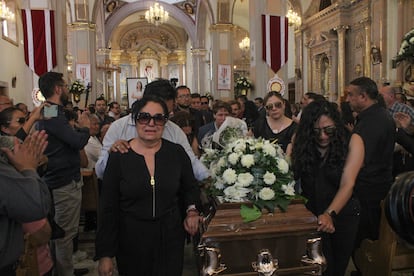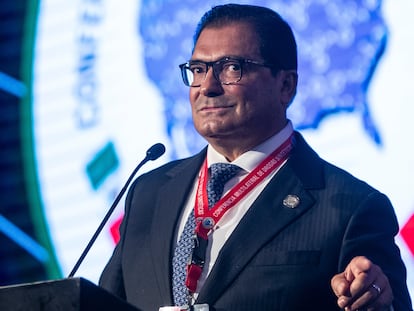Mexico is heading towards its most violent election ever, with 30 candidates murdered, 77 threatened and 11 kidnapped
More than 170 attacks have been committed against politicians in the lead-up to the June elections. This violence has put campaigns under tension and is sowing doubts about governability in several regions. Specialists warn that the line between the Mexican state and organized crime is increasingly blurred

Electoral violence is going unchecked in Mexico. Noé Ramos Ferretiz, a candidate for the municipal presidency of Mante, a city in the state of Tamaulipas, was campaigning last Friday when he was stabbed several times. The politician, who is a member of the National Action Party (PAN), died in the middle of the event, to the shock of his supporters. Overwhelming images of blood-stained leaflets circulated afterwards.
The main suspect fled without a trace, in broad daylight. He would be arrested by the end of the weekend. Hours after the crime in Mante, the body of Alberto Antonio García, a mayoral candidate for the ruling party, MORENA, was found in the city of San José Independencia, in the state of Oaxaca. His wife, a councilor in the town of fewer than 5,000 inhabitants, was released alive after being kidnapped for two days.
The murders of Ramos Ferretiz and Antonio García are the latest two cases to be registered during the 2024 electoral process. So far in this election cycle, 30 candidates have already been murdered, according to data from the think tank Laboratorio Electoral (“Electoral Laboratory”).
In 2021, at least 30 contenders were murdered, according to data from the consulting firm. In the 2018 process, there were 24 political assassinations. With just under 40 days before Mexicans go to the polls on June 2, the vote is close to becoming the most violent one in recent years. “The phenomenon of electoral violence has been growing in the country and is increasingly spreading. It’s not only a question of numbers, but also of territorial expansion: there are more red flags, more [areas] with a higher incidence of violence, more attacks,” says Arturo Espinosa Silis, director of Laboratorio Electoral. “I don’t think we have to wait for the number of fatalities to be exceeded… this electoral process has been more violent when other aspects are looked at, such as assaults and threats,” adds Daniela Arias, the organization’s coordinator.
EL PAÍS has analyzed the consulting firm’s findings from the last 10 months, to better understand the spiral of violence that surrounds this conflict, which has left a trail of more than 170 attacks, including 29 assaults, 11 kidnappings and 77 death threats. At least 27 other killings of those who weren’t seeking elected office, such as relatives of officials, political organizers, community leaders and incumbent politicians, have also been logged. This data was last updated on April 19.
Insecurity is spreading faster than the statistics. Just this past Tuesday, April 23, an armed group tried to assassinate Arturo Lara, the mayoral candidate for the Citizens’ Movement in Amanalco, a municipality in the state of Mexico (Edomex), which surrounds the capital. The Institutional Revolutionary Party (PRI) also announced that its candidate for the municipal presidency in Zacapu, in the state of Michoacán, Lorenzo Martínez, dropped out of the race due to threats.
Lethal violence against people seeking elected office has reached 13 of the country’s 32 states. It’s concentrated in the center and south of the national territory. “The red flags are in Michoacán, Guerrero and Chiapas,” Espinosa Silis explains. Seven of the 30 murders of candidates have occurred in the state of Guerrero. Four more were registered in Michoacán and another three in Chiapas. Oaxaca, Edomex, Guanajuato, Jalisco, Puebla and Veracruz have had two cases each, while Mexico City, Colima, Morelos and Tamaulipas have each had one.
In many cases, the registration of these candidates hadn’t even been made official, or their political campaigns hadn’t even started. Arias explains that the pre-campaign and inter-campaign period — the pause before the final stretch of the race begins — are usually moments when political violence worsens. The logic is that organized criminal groups seek to exercise political control in the territories they dominate. It’s the criminal organizations who authorize who can compete and govern, in an effort to pull the strings of local authorities. “It’s a way to pressure and condition the decisions of political parties,” she says.
Manuel Pérez Aguirre, a researcher from the College of Mexico who specializes in organized crime, agrees that the selection of candidates tends to be a fraught period. “February and March tend to be very violent months, because that’s when [the parties decide] who they will put up as candidates,” he points out. To analyze the violence that took place during the 2021 elections, Pérez Aguirre and his fellow researchers started with the hypothesis that the cartels were interfering in the political process. While this was partially corroborated, they also realized that organized crime isn’t the only relevant actor behind the murders. The politicians themselves are also involved: some seek to win their positions “with bullets.”
When criminal groups manage to infiltrate local governments — and when they seek to maintain that control in various electoral processes — the analysis falls into a gray area, as the line that divides the state from organized crime becomes increasingly blurred. “In many cases, a separation between a mayor who was probably the perpetrator and a criminal group couldn’t be established as such,” Pérez Aguirre notes, as he reflects upon a recent study that he co-authored.
Homicides aren’t the only acts of intimidation. Michoacán is the state where the most threats are registered: 34 candidates have dropped out of the race after being intimidated by criminals. This phenomenon has affected seven of the 11 parties registered in the western state. “‘You don’t have permission’ — those are the words they use,” Antonio Plaza laments, in a conversation with EL PAÍS. He’s the leader of Michoacán Primero (“Michoacán First”), a local party that’s competing for the first time.
Morelos is the state with the second-highest number of candidates under threat — 14 — with Chiapas close behind, at 13. Arias points out that even though the political groups themselves are the ones who report that they’ve been intimidated, these acts often don’t translate into formal police complaints. This prevents the authorities from acting and investigating. In many cases, threats aren’t made public and politicians opt to lower their public profile out of fear.
Chiapas and Guerrero are also the states where the most political contenders have been kidnapped, with three cases each. Guanajuato and Sinaloa, territories plagued by violence in recent years, have also recorded at least one kidnapping each, as have the states of Oaxaca, Puebla and Hidalgo. Laboratorio Electoral’s compilation also reports six attacks in Guerrero, five in Morelos, as well as four in Mexico City and in eight other states, from Tamaulipas and Nuevo León to the traditionally quiet Campeche.
The victims overwhelmingly hail from local, rather than national politics: they tend to be candidates for mayor, or for the state legislature. “What we’re seeing is that there are areas of the country where there’s a total absence of the state, where neither the security forces nor local governments can act,” Espinosa Silis emphasizes. “There’s no way to put a large amount of resources into each and every one of the police forces in the 2,500 municipalities,” Pérez Aguirre adds. He also sees the municipal order as the weakest link within the Mexican state.
The violence has reached all registered political parties. MORENA is the party with the highest number of murdered candidates: 10 have been killed so far in the 2024 election cycle.
The murder of Gisela Gaytán, the mayoral candidate in the city of Celaya, was even mentioned in the daily conference given by President Andrés Manuel López Obrador, as she was a candidate from his party. The government has been forced to publicly recognize at least 15 murders during this electoral process. “These are people who are fighting to assert democracy, who are in the streets showing their faces, fighting for others… it hurts a lot that this happens in our country,” the president said in early April.
The parties’ positions on electoral violence have become part of the campaign. At one extreme, the ruling coalition has been reticent before the opposition’s criticism, in an attempt to ensure that the security strategy of the current administration isn’t questioned. On the other hand, opponents have tried to bring insecurity to the ballot box, in order to capitalize on popular discontent. Gaytán’s case broke that pattern when it happened in Guanajuato, the state most devoted to the opposition and the only one that voted for the PAN in 2018. “It was the first time that MORENA got worried and took up the issue… even the president [mentioned it], " Espinosa Silis notes.
The PAN is the second-most affected party when it comes to the murder of its candidates, although it’s the leading victim when it comes to other types of assaults. The Party of the Democratic Revolution (PRD) and the Citizens’ Movement stand out for the number of assaults, despite the fact that they’re relatively smaller parties. Each registered political party has experienced at least one fatality in this cycle.
Of the 30 murdered candidates, 27 were men and three were women. However, the impact on women is multiplied when other types of attacks are taken into consideration: they constitute almost a third of all victims of political violence. Furthermore, between June of 2023 and February of 2024, more than 50 people have been sanctioned for gender-based political violence.
Although the phenomenon of political violence isn’t new, studies about it certainly are.
This has caused many differences between the numbers presented by each consulting firm. “The authorities don’t have official figures,” Espinosa Silis sighs. For example, Etellekt Consultores counted 36 murders of candidates in 2021, the same number as the Integralia Group, although there are differences regarding where the assassinations occurred and against whom. In a report published by Pérez Aguirre and his fellow researchers at the College of Mexico, 32 cases of political candidates being murdered were reported, two more than Laboratorio Electoral.
“Mexico has a long history of electoral violence, even since its creation as a state,” Pérez Aguirre says. He recalls that one can go all the way back to the assassination of presidential candidate Luis Donaldo Colosio (1994), or even President Álvaro Obregón (1928). The current dynamic, however, is different: the violence is largely a byproduct of the drug war. The lines between political violence and criminal violence have also become blurred: attacks have become normalized in contexts that are touched by other types of violence. “It’s something much more systematic, much more ‘normal,’ much more common… and one that occurs at the local level,” Pérez Aguirre adds.
The cycle of violence begins and ends with impunity. In the report recently published by the College of Mexico, it’s noted that, in 2021, there were no arrests in more than half of the cases analyzed. Overall, the percentage of cases that culminated in a prison sentence was minimal. “Arrests [made by the authorities] to appear effective were common, without this giving way to a true clarification about the homicides,” the report reads. Specialists note that cases related to this process have raised doubts about the viability of elections and the prevalence of “criminal governance” in some regions. In Maravatío, a city in the state of Michoacán, the MORENA and PAN candidates for the municipal presidency, Miguel Ángel Zavala and Armando Pérez Luna respectively, were murdered in February, just hours apart. Months earlier, Dagoberto García, a candidate for a local party, who also had a good chance of winning the post, was also killed. In the cities of Acapulco and Chilapa, both located in the state of Guerrero, there have also been multiple assassinations of political contenders.
A look at the victims beyond the aspirants sheds light on the dynamics of intimidation and deterrence in local Mexican politics. Since June of 2023, when the succession game was inaugurated within MORENA and there was an informal start to the contest, 10 relatives of politicians have been murdered. This year, in Fresnillo, in the state of Zacatecas, the murders of Juan Pérez Guardado and Jorge Antonio Monreal — the brother-in-law and nephew of Senator Ricardo Monreal respectively — put the attacks that affect the politicians’ environment under the magnifying glass. The list of victims includes nephews, brothers, wives and in-laws, among others. Last week, José Margay Coutiño, a councilor in Villa de Corzo, in Chiapas, was murdered.
Putting the focus on these incidents reveals the double effect of a “democracy that’s conditioned and limited by violence,” according to Espinosa Silis. Three pollsters — Data Cívica, México Evalúa and Animal Político — estimate that each political murder impacts citizen participation by more than 1%, due to the fear of going out to vote. These killings also affect those who compete: oftentimes, political parties cannot fill vacancies and their options are limited to those who dare or “are allowed” to run. For instance, in Jilotlán de las Flores, a city in the state of Jalisco, only one candidate reached the end of the 2021 mayoral campaign, due to intimidation by organized crime. The local Electoral Court ultimately annulled the election. That same year, voting was annulled in four municipalities across the state of Michoacán, due to the interference of organized crime. This was an unprecedented step by the electoral authorities.
In the 2024 election cycle, the impact of violence has been increasingly visible. It’s a permanent reminder that, in large swaths of Mexico, getting involved in politics is a matter of survival.
Sign up for our weekly newsletter to get more English-language news coverage from EL PAÍS USA Edition
Tu suscripción se está usando en otro dispositivo
¿Quieres añadir otro usuario a tu suscripción?
Si continúas leyendo en este dispositivo, no se podrá leer en el otro.
FlechaTu suscripción se está usando en otro dispositivo y solo puedes acceder a EL PAÍS desde un dispositivo a la vez.
Si quieres compartir tu cuenta, cambia tu suscripción a la modalidad Premium, así podrás añadir otro usuario. Cada uno accederá con su propia cuenta de email, lo que os permitirá personalizar vuestra experiencia en EL PAÍS.
¿Tienes una suscripción de empresa? Accede aquí para contratar más cuentas.
En el caso de no saber quién está usando tu cuenta, te recomendamos cambiar tu contraseña aquí.
Si decides continuar compartiendo tu cuenta, este mensaje se mostrará en tu dispositivo y en el de la otra persona que está usando tu cuenta de forma indefinida, afectando a tu experiencia de lectura. Puedes consultar aquí los términos y condiciones de la suscripción digital.
More information
Archived In
Últimas noticias
Welcome to the post-religion era: The idea of Christianity as the absolute truth has become obsolete
‘I thought you would like it’: The risky sexual practice popularized by TV shows and TikTok
The digitalization of tourism: ‘They promise experiences and gave us the worst possible one’
Mexican peso defies uncertainty with forecasts of a new period of stability in 2026
Most viewed
- Sinaloa Cartel war is taking its toll on Los Chapitos
- Reinhard Genzel, Nobel laureate in physics: ‘One-minute videos will never give you the truth’
- Oona Chaplin: ‘I told James Cameron that I was living in a treehouse and starting a permaculture project with a friend’
- Why the price of coffee has skyrocketed: from Brazilian plantations to specialty coffee houses
- Silver prices are going crazy: This is what’s fueling the rally










































